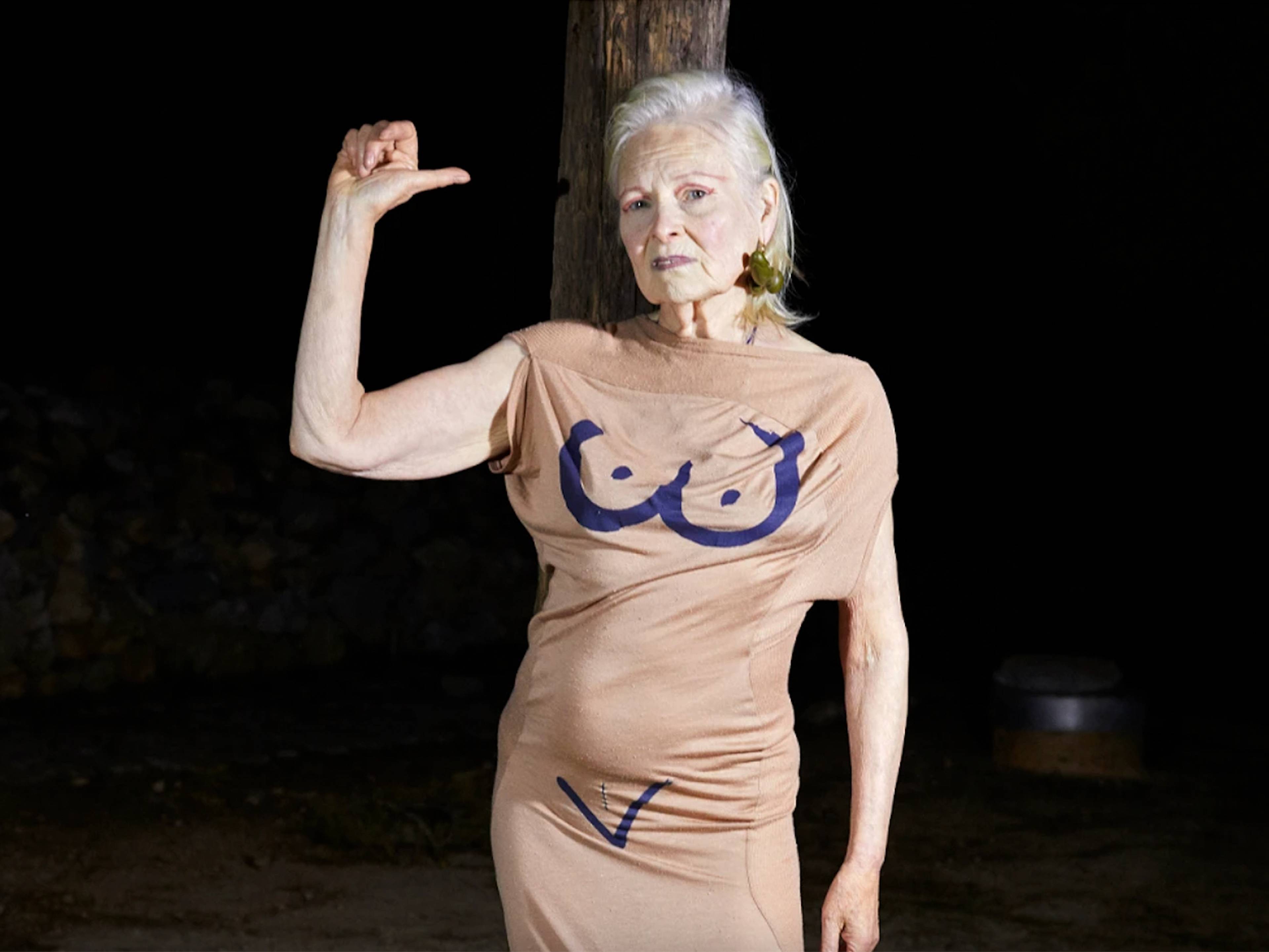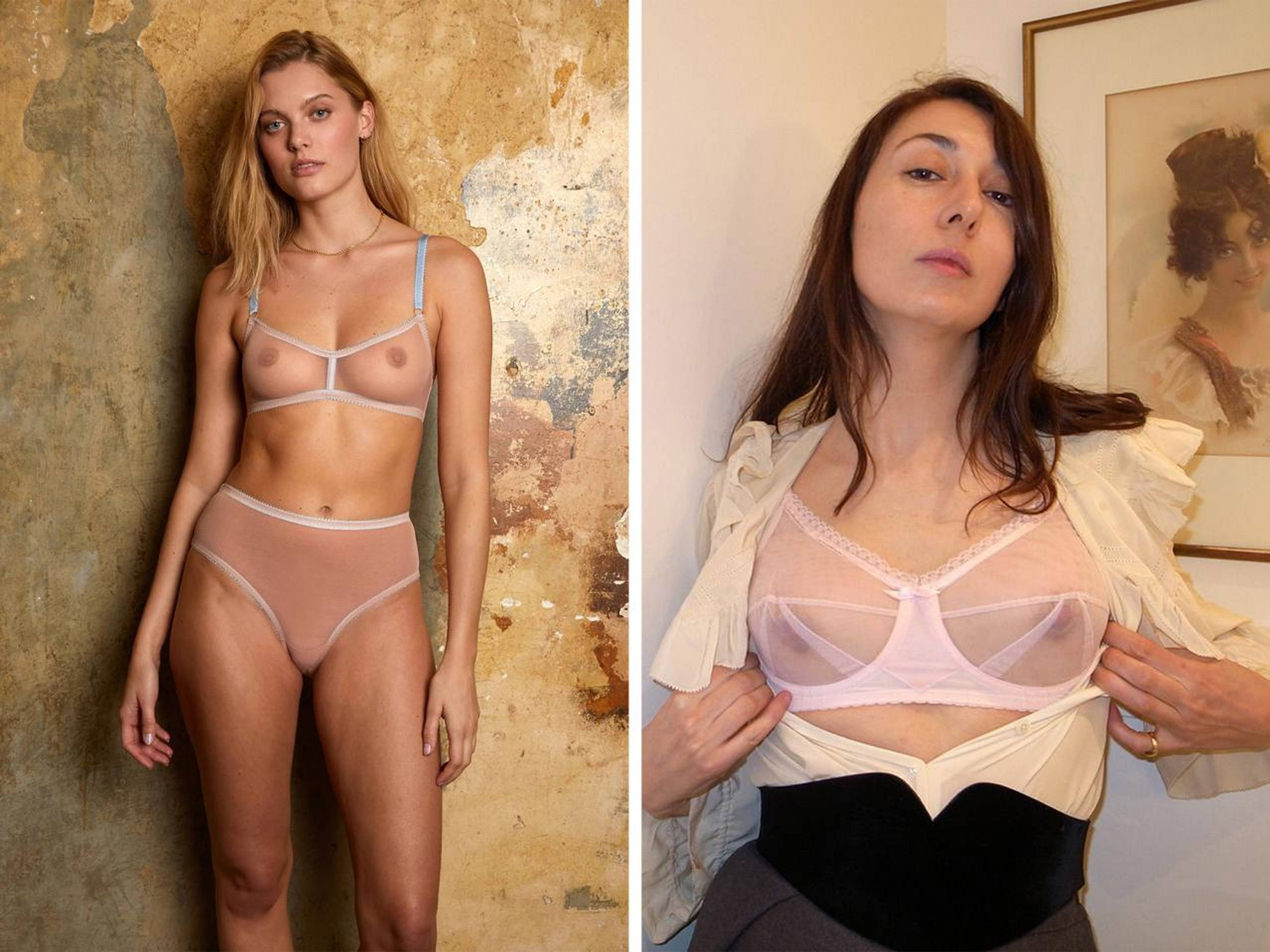I needed invisible underwear to wear under white: I bought a bra and briefs the color of my skin, made of fine mesh. They do their job – kind of. When worn, they are almost transparent: You can see my nipples, you can see my bush.
“If fashion is your business,” sang Jarvis Cocker, “then when you’re naked/I guess you must be unemployed.” He may have been singing about his (now ex-) wife, the stylist Camille Bidault-Waddington. When I said my underwear “does its job,” what job would that be? And why is being undressed such hard work?
Not having a fashionable body, I look naked in the way fashion models don’t. Models’ flesh is a garment: perfectly cut. Mine, unshaped by clothes, folds, protrudes, or sags in places. In order to be undressed, I feel I have to add something. Freud wrote that the only technology invented by women was weaving, made in imitation of pubic hair: each garment a merkin, a fake bush to hide the shame he assumed they would have at the original, both of which were coverings for what he called a lack. This was not lack in women’s own eyes, but in the eyes of the guy who beheld them. And the shame was not their shame, but his terror that, if anyone could lack a dick, he might soon too. My underwear is a castration complex pun: I’m wearing something that covers my “lack,” yet shows it off. I am totally covered, but totally nude. I am not naked, but I am undressed.
Is it possible to have style almost, or completely, undressed?
Left: Dora Larsen Margo set; right: stylist Camille Bidault-Waddington wears Cadolle
In The Truth in Painting (1978), Jacques Derrida talks about the “parergon” – the predicate of a portrait. It’s what isn’t quite the subject of the work, but the “decoration.” Does he mean the background landscape or interior setting, the frame itself? Or does he mean the sitter’s clothes? “One wonders,” Derrida asks, “where to have clothing commence. Where does a parergon begin and end. Would any garment be a parergon . G-strings and the like. What to do with absolutely transparent veils. And how to transpose the statement to painting. For example, Cranach’s Lucretia (1533) holds only a light band of transparent veil in front of her sex: Where is the parergon?”
Of course, a painted or a sculpted veil does not “veil” anything. As it cannot be removed, it hides nothing, but this is a different nothing from the veils Derrida describes in Eperons: Nietzsche’s Spurs (1979). While the parergon hides something concrete but unexpected – not a body, but the material of the artwork, like canvas or stone – “truth” is an onion-skin series of “veils.” It does not “hide” anything, but presents as an action: a never-ending process of revealing. In Eperons , truth is equated with the “feminine.”
Worn for a few hours, SHEER NYLON TIGHTS smell of the body, but also of their manufactured selves. They are what is strange and what is familiar: the Freudian uncanny.
The action of undressing, rather than being completely dressed or undressed, reminds me of that old catwalk trick, most recently seen at Miu Miu FW23: spice up “boring” wearable outfits by … removing the models’ skirts or pants.
There was something much more interesting, in the same show, about the less obviously sexy look of tights pulled visibly up above the waistband of skirts. Like the underwear I bought, there’s something fleshly about their transparency, but the obvious seams indicate that they are artificial. The transgression of showing the un-showable parts of a garment that covers the parts of the body that also “shouldn’t” be shown makes them sexy. I’ve always found sheer nylon tights a repulsive turn-on, particularly when they’re “flesh-colored.” They have the fascination of a synthetic body. Worn for a few hours, they smell of the body, but also of their manufactured selves. They are what is strange and what is familiar: the Freudian uncanny.
Their weird half-resemblance to the body, but their ability to be removed, also makes them a fetish. Freud counts fetishism as a het guy thing: Men fixate on the objects women wear – woven or otherwise – that disguise their “lack,” because lack in anyone suggests the possibility of castration. They satisfy desire without the danger of a real encounter. “There is no unhappier creature under the sun than a fetishist who longs for a woman’s shoe but has to make do with the whole woman,” wrote the Austrian aphorist, Karl Kraus, in Freudian Vienna in 1909.
Miu Miu FW 23
But what is it to be the employer of such fetishes: the woman wearing them? Riffing on Freud, Lacan’s phallic mother doesn’t care about not having a dick: She wields symbolic power via language, without the need for backup from the physical. Unassailable, she may be unemployed in the radical sense, having (unlike the dick-haver) no need to work it. She’s not “undressed.” Having no need for a fetishistic intermediate layer, she can appear really naked.
Which brings us back to work, and to the labor done by Miu Miu’s tights. Pulled up above the skirt’s waistband, the parts that show are not the smooth illusion of sex but the literal “seamy side” – the side that makes them “work.” What is being employed here is not the fetish, but the scaffolding that makes the fetish possible. It shows the artificiality of the whole construct, as though the parergon revealed the canvas – not the body – that hides underneath. The intention of the Miu Miu tights may be less sexual than political: The look exposes the seams of women’s work and the artificiality of gender.
My “nude” underwear allows me to believe two things at once: that I “am” the perfect capitalistic body exactly because I am not.
“Everything is political,” said Miuccia Prada, Miu Miu’s eponymous head and sometime Communist Party member, in 2020. Perhaps my underwear covers my shame, not at not having a dick, but not having the “right” kind of body under patriarchal capitalism – which is simultaneously to say that my body is always already the right patriarcho-capitalist body, as I’m constantly willing to buy something to fix it. Like Derrida’s “truth,” its nature is that it is always in progress.
My “nude” underwear allows me to believe two things at once, just as Freud’s fetish allows men to believe that its presence both points up a woman’s “lack” by covering it and simultaneously denies it, by “fixing” that lack. My underwear tells me that I “am” the perfect capitalistic body exactly because I am not.
Disavowal, as Slavoj Žižek wrote, is the condition for such acts of belief, where the “act” or process (as in Derrida’s veils) is the thing. It might even allow Miuccia Prada to believe in communism while running a luxury goods brand. The stylishness of Miu Miu’s tights is conditional on an understanding that they are “not” stylish, whereas the same act as a “mistake” would not be stylish at all – though it may be an appealing eccentricity.
Miu Miu’s catwalk gesture is the reverse of the emperor’s new clothes, where his audience was asked to act out belief (in a double Žižekian sense) that clothes were there, even though it knew they were not. At Miu Miu, clothes that should be “invisible” were palpably present: We are asked to overturn Žižek’s double act of disavowal and rely on the evidence of our eyes. This re-veiling opposes Derrida’s idea that the production of truth is a constant unveiling. What is exposed at Miu Miu is what is really there. Those visible tights are a parergon that, while seeming to hide something, hides nothing, not even itself. The tights reclaim the fetish as a real object, material, concrete, and separate from the body. It’s this separation that allows the body and what is worn to come together as style.
Lucas Cranach the Elder, Lucretia, 1533, oil on beechwood, 37.5 x 24 cm. © Staatliche Museen zu Berlin, Gemäldegalerie / Volker-H. Schneider
___





